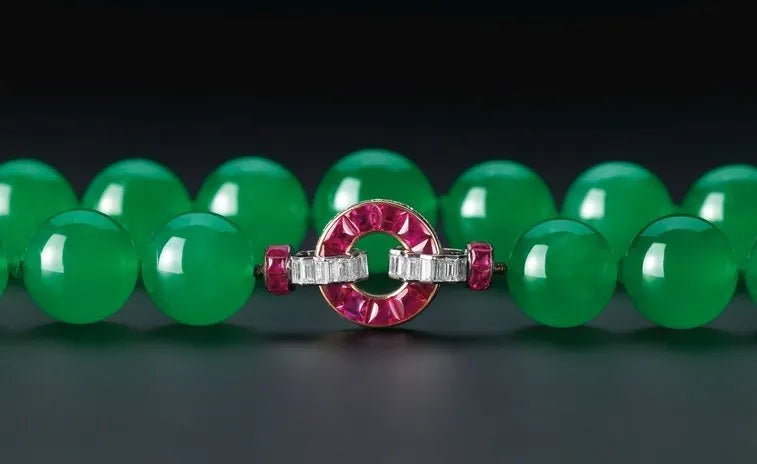
Gemmological Nomenclature vs Scientific Nomenclature
Share
The so called "gem materials" that are used in jewellery and objects d'art come from a variety of materials, including minerals, rocks, fossils, biogenic substances, organic substances and a wide range of artificial products (e.g. synthetic stones, composite stones). Every natural or artificial substance in these groups are, to a lesser or greater extent, object of study of diverse disciplines that include mineralogy (e.g. minerals: diamond, quartz, topaz), petrology in its magmatic, metamorphic or sedimentary sub-disciplines (e.g. rocks: lapis lazuli, aventurine quartz, jadeitite), palaeontology (e.g. fossils: ammolite, amber), zoology (e.g. pearl, shell, coral), botany (e.g. corozo, copal), solid state physics (e.g. artificial products: cubic zirconia, synthetic sapphire), among many other possible scientific approaches. There are, therefore, academic fields of expertise that produce science and knowledge that is communicated with very specific rules and nomenclature accepted by the scientific community. This research data, usually published in peer reviewed papers in scientific journals, is often too complex for the non-scientist to fully understand and appreciate. The complexity of modern gemmology, in an increasingly convergent route with science, has been behind the increasing complexity of the articles published in gemmological journals (e.g. The Journal of Gemmology, Gems & Gemmology) that is a challenge for the editors since their audience is mostly composed of professionals of the gem and jewellery industry, not members of the scientific community, requiring reader friendly formats.
Early Gemmology and Science
Gemmology, as a discipline, emerges in the late 19th century as response to the needs for consumer confidence and product knowledge in the jewellery industry, namely in the identification of precious stones and their substitutes. An advertisement in 1893 announces a six lecture course on "Gemmology, or the Science of Gems" in London, being probably on of the first structured educational events on record. The use of the word "science" might, however, be understood as a marketing strategy to introduce credibility on such a new subject. It is curious to note that the first gemmological diplomas in Europe were named "Mineralogy for Jewellers", issued by the National Association of Goldsmiths in London in 1911. The title reveals the need for adaptation of a scientific discipline to a consuming product driven industry. It also shows that in the early days of gemmology as a systematic branch of knowledge, the expertise and contribution of members of the Earth sciences community was paramount to its development, a reality that still stands today.

The jewellery industry produces, promotes and ultimately sells jewellery to the public, an activity that goes way back in time. Gem materials, as products and leading players in this decorative art, were historically categorised and named via interesting empirical knowledge. In this historical context, many trade names have been used and reused through both verbal and written tradition in the various local vernaculars and languages throughout the globe. Only occasionally, did these names emanate, for example, from the Earth Sciences community that experienced significant advancements only in the 18th-19th centuries. Gemstone designations were pretty much associated with visual characteristics like colour (e.g. sapphire, chrysolite, aquamarine) and texture (e.g. agate, aventurine) or with commercial provenance (e.g. turquoise, tanzanite) in a very informal, sometimes romantic, way. The name "balas ruby" as a purported ruby from Balas, is a good example. In reality, these red gems are spinels and they mostly came from the Kuh-i-Lal region in the Pamir mountains in today's Tajikistan, a region historically known as Badakshan, hence the Balas or Ballas designation. Famous examples include the Timur Ruby, the Black Prince Ruby and other Mughal period polished drilled beads.

In those days, nomenclature was not much of a problem, since these designations intended to communicate products, not study materials, to a rather limited and strict elite in a period when science was not developed enough nor strong enough to inspire an industry to set standards. The inheritance of naming traditions is on the base of many of the current trade names, which are currently scrutinised as acceptable or not-acceptable by trade organisations. These organisations play a key role in setting consistent standards to promote and maintain confidence among consumers that have greatly expanded to a massive audience of global proportions. In this scrutiny, science is taken into consideration as the gemmological community today has a considerable knowledge background, but tradition and consumer protection are also considered, bering in mind that nomenclature in the jewellery industry is there to serve the consumer.


Modern Gemmology and Science
It is important to underline that Gemmology is not, strictly speaking, a science. In spite its foundations in scientific knowledge, gemmology began as a systematic set of methods to positively identify and classify gem materials in consumer products. Among the first challenges of the early gemmologists was the detection of flame fusion synthetic rubies in the dawn of the 20th century and the identification Akoya cultured pearls to separate them from the much more valuable natural pearls in the 1920's. Gemmology, therefore, established protocols and non-destructive methods for the identification of the materials that were used in jewellery and in objects d'art, from the simple paste (glass) to the more valuable diamond.

Basil Anderson (1901-1984) was a leading figure in early gemmology as head of the Pearl, Diamond and Precious Stone section of the London Chamber of Commerce open in 1925 © The Journal of Gemmology, Gem-A
It is also crucial to emphasise that gemmologists have consistently strengthen bonds with the scientific community due to several reasons: the advancements in earth sciences, solid state physics and biology; the evolution of technology in both treatments, crystal growth, pearl farming and analytical instrumentation; the increasing number of gem materials and new locality sources; the consumer demand for information on specific issues that are considered pertinent to gauge the perceived value of gem products (e.g. treatments, modern synthetics, geographic origins), among other developments. That can be easily demonstrated in the afore mentioned gemmological periodicals where the complexity of the information that is offered to the reader in peer reviewed articles is sometimes hard to digest for the average practicing gemmologist. The increasing number of PhD graduates and research fellows in various fields of expertise (not only mineralogy) in the staff of the more advanced and well prepared gemmological laboratories around the world also demonstrate the seriousness of the matters at hand. The cost of setting up a modern gemmological laboratory is now massive, namely in acquiring and maintaining the complex instrumentation needed to face the more delicate challenges (e.g. LA-ICP-MS, SIMS, LIBS, PL Spectroscopy, X- ray Tomography) and to build up data-bases based on samples collected in-loco on the various mine sites.

© SSEF
Setting Nomenclature Standards
These paragraphs served to demonstrate that, today, gemmology and science work hand in hand more than ever to serve an industry that promotes and sells products with the mission of maintaining consumer confidence. But the nuclear focus of this essay is nomenclature and, in light of this gemmology-science compromise, the question is if trade nomenclature should follow the strict academic framework or should it follow a more relaxed vision, sometimes romantic by tradition. Or is it both.
